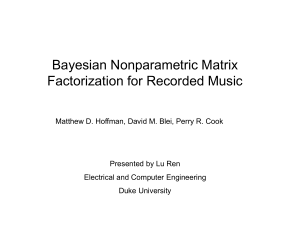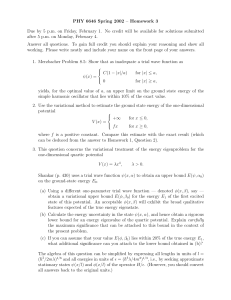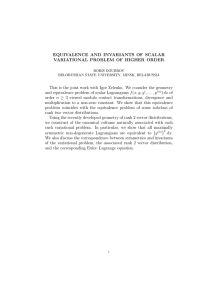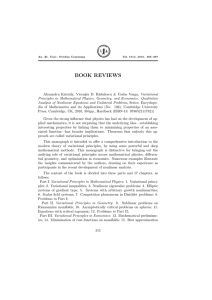A generalized form of Ekeland’s variational principle Csaba Farkas
advertisement
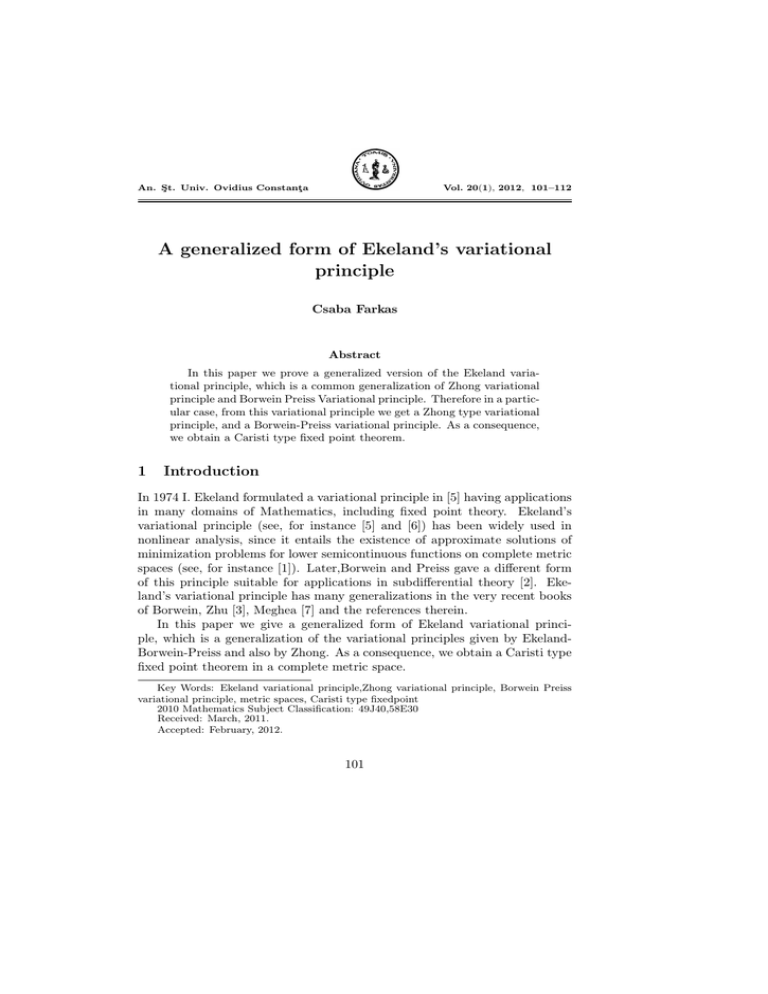
An. Şt. Univ. Ovidius Constanţa
Vol. 20(1), 2012, 101–112
A generalized form of Ekeland’s variational
principle
Csaba Farkas
Abstract
In this paper we prove a generalized version of the Ekeland variational principle, which is a common generalization of Zhong variational
principle and Borwein Preiss Variational principle. Therefore in a particular case, from this variational principle we get a Zhong type variational
principle, and a Borwein-Preiss variational principle. As a consequence,
we obtain a Caristi type fixed point theorem.
1
Introduction
In 1974 I. Ekeland formulated a variational principle in [5] having applications
in many domains of Mathematics, including fixed point theory. Ekeland’s
variational principle (see, for instance [5] and [6]) has been widely used in
nonlinear analysis, since it entails the existence of approximate solutions of
minimization problems for lower semicontinuous functions on complete metric
spaces (see, for instance [1]). Later,Borwein and Preiss gave a different form
of this principle suitable for applications in subdifferential theory [2]. Ekeland’s variational principle has many generalizations in the very recent books
of Borwein, Zhu [3], Meghea [7] and the references therein.
In this paper we give a generalized form of Ekeland variational principle, which is a generalization of the variational principles given by EkelandBorwein-Preiss and also by Zhong. As a consequence, we obtain a Caristi type
fixed point theorem in a complete metric space.
Key Words: Ekeland variational principle,Zhong variational principle, Borwein Preiss
variational principle, metric spaces, Caristi type fixedpoint
2010 Mathematics Subject Classification: 49J40,58E30
Received: March, 2011.
Accepted: February, 2012.
101
102
2
Csaba Farkas
A generalized form of Ekeland’s variational principle
In this section we give a common generalization of the variational principles
of Borwein-Preiss-Ekeland [3] and Zhong [9].
First, we recall some notions used in our results, such as lower semicontinuous or proper functions. For this let (X, d) be an arbitrary metric
space:
Definition 2.1. Let f : X → R ∪ {+∞} be a function. We say that the
function f is lower semicontinuous at x0 ∈ X if
lim inf f (x) = f (x0 ),
x→x0
where lim inf f (x) =
x→x0
sup
inf f (x), where V(x0 ) is a neighborhood system
V ∈V(x0 ) x∈V
of x0 .
Definition 2.2. Let f : X → R be a function. We define the following set
D(f ) = {x ∈ X|f (x) < ∞}.
We say that the function f is proper if D(f ) ̸= ∅.
Now, we prove our main result.
Theorem 2.1. Let h : [0, +∞) → [0, +∞) be continuous non-increasing function. Let (X, d) be a complete metric space and f : X → R ∪ {+∞} be
a proper, lower semi-continuous function bounded from below. Suppose that
ρ : X × X → R+ ∪ {∞} is a function, satisfying:
(i) for each x ∈ X, we have ρ(x, x) = 0;
(ii) for each (yn , zn ) ∈ X×X, such that ρ(yn , zn ) → 0 we have d(yn , zn ) → 0;
(iii) for each z ∈ X the function y 7→ ρ(y, z) is lower semi-continuous function.
Let δn ≥ 0 (n ∈ N∗ ) be a nonnegative number sequence and δ0 > 0 a positive
number. For every x0 ∈ X and ε > 0 with
f (x0 ) ≤ inf f (x) + ε,
x∈X
(2.1)
there exists a sequence {xn } ⊂ X which converges to some xε (xn → xε ) such
that
ε
(2.2)
h(d(x0 , xn ))ρ(xε , xn ) ≤ n , for all n ∈ N.
2 δ0
103
A generalized form of Ekeland’s variational principle
If δn > 0 for infinitely many n ∈ N, then
f (xε ) + h(d(x0 , xε ))
∞
∑
δn ρ(xε , xn ) ≤ f (x0 ),
(2.3)
n=0
and for x ̸= xε we have that
f (x) + h(d(x0 , x))
∞
∑
δn ρ(x, xn ) > f (xε ) + h(d(x0 , xε ))
n=0
∞
∑
δn ρ(xε , xn ). (2.4)
n=0
If δk > 0 for some k ∈ N∗ and δj = 0 for every j > k, then for each x ̸= xε
there exists m ∈ N, m ≥ k such that
f (x) + h(d(x0 , x))
k−1
∑
δi ρ(x, xi ) + h(d(x0 , x))δk ρ(x, xm ) >
i=0
f (xε ) + h(d(x0 , xε ))
k−1
∑
δi ρ(xε , xi ) + h(d(x0 , xε ))δk ρ(xε , xm ).
(2.5)
i=0
Proof. In the first case, for infinitely many n ∈ N, without loss of generality,
we can assume that δn > 0, for every n ∈ N. We can define the following set:
W(x0 ) = {x ∈ X|f (x) + h(d(x0 , x))δ0 ρ(x, x0 ) ≤ f (x0 )} .
(2.6)
By the assumption (i), we have that ρ(x0 , x0 ) = 0, so x0 ∈ W(x0 ). Therefore
the set W(x0 ) ̸= ∅. From the lower semi-continuity of the functions f and
ρ(y, ·) and continuity of function h, we have that W(x0 ) is closed subset of X.
We can choose x1 ∈ W(x0 ), such that
f (x1 )+h(d(x0 , x1 ))δ0 ρ(x1 , x0 ) ≤
inf
x∈W(x0 )
and set again:
{
W(x1 ) =
x ∈ W(x0 )|f (x) + h(d(x0 , x))
{f (x) + h(d(x0 , x))δ0 ρ(x, x0 )}+
1
∑
ε · δ1
2δ0
}
δi ρ(x, xi ) ≤ f (x1 ) + h(d(x0 , x1 ))δ0 ρ(x1 , x0 )
i=0
Similarly as above, we have that W(x1 ) ̸= ∅ (since x1 ∈ W(x1 )), and W(x1 ) is
non-empty closed subset of W(x0 ), which means that W(x1 ) is a non-empty
closed subset of X as well.
Using the mathematical induction we can define a sequence xn−1 ∈ W(xn−2 )
and W(xn−1 ) such that:
W(xn−1 ) = {x ∈ W(xn−2 )|f (x) + h(d(x0 , x))
n−1
∑
i=0
δi ρ(x, xi ) ≤
104
Csaba Farkas
f (xn−1 ) + h(d(x0 , xn−1 ))
n−2
∑
δi ρ(xn−1 , xi )}.
i=0
It is easy to see that W(xn−1 ) ̸= ∅, and W(xn−1 ) is closed subset of X. We
can choose xn ∈ W(xn−1 ) such that
f (xn ) + h(d(x0 , xn ))
n−1
∑
δi ρ(xn , xi ) ≤
i=0
{
≤
inf
x∈W(xn−1 )
f (x) + h(d(x0 , x))
n−1
∑
δi ρ(x, xi )
δn · ε
,
2n δ0
+
i=0
and we can define the set
{
W(xn ) =
}
x ∈ W(xn−1 )|f (x) + h(d(x0 , x))
n
∑
δi ρ(x, xi ) ≤ f (xn ) + h(d(x0 , xn ))
i=0
n−1
∑
}
δi ρ(xn , xi )
i=0
which is closed subset of X.
Let z be an arbitrary element of W(xn ) . Then from the definition of
W(xn ) we have the following inequality
f (z) + h(d(x0 , z))
n
∑
δi ρ(z, xi ) ≤ f (xn ) + h(d(x0 , xn ))
i=0
n−1
∑
δi ρ(xn , xi ) ⇔
i=0
⇔ f (z)+h(d(x0 , z))δn ρ(z, xn )+h(d(x0 , z))
n−1
∑
δi ρ(z, xi ) ≤ f (xn )+h(d(x0 , xn ))
i=0
i=0
Then, we obtain
[
h(d(x0 , z))δn ρ(z, xn )
≤
f (xn ) + h(d(x0 , xn ))
− f (z) + h(d(x0 , z))
n−1
∑
f (xn ) + h(d(x0 , xn ))
[
−
≤
]
δi ρ(xn , xi ) −
]
δi ρ(z, xi ) ≤
i=0
[
≤
n−1
∑
i=0
[
inf
x∈W(xn−1 )
δn ε
,
2n δ0
n−1
∑
n−1
∑
]
δi ρ(xn , xi )
i=0
f (x) + h(d(x0 , x))
n−1
∑
i=0
]
δi ρ(x, xi )
δi ρ(xn , xi ).
105
A generalized form of Ekeland’s variational principle
therefore
h(d(x0 , z))ρ(z, xn ) ≤
ε
2n δ
.
(2.7)
0
So, if n → ∞, then ρ(z, xn ) → 0. Then from (ii) it follows that d(z, xn ) →
0. Therefore diam(W(xn )) → 0, whenever n → ∞ and we obtain a descending
sequence {W(xn )}n≥0 of nonempty closed subsets of X,
W(x0 ) ⊃ W(x1 ) ⊃ .... ⊃ W(xn ) ⊃ ...
such that diam(W(xn )) → 0, as n → ∞. Applying the Cantor intersection
theorem for the set sequence {W(xn )}n∈N , we have that there exists an xε ∈ X
such that
∞
∩
W(xn ) = {xε }.
n=0
We can observe that z = xε satisfies the inequality (2.7), therefore xn → xε .
If x ̸= xε , then there exists m ∈ N such that
f (x)+h(d(x0 , x))
m
∑
δi ρ(x, xi ) > f (xm )+h(d(x0 , xm ))
i=0
m−1
∑
δi ρ(xm , xi ). (2.8)
i=0
It is clear that if q ≥ m then
f (xm ) + h(d(x0 , xm ))
m−1
∑
δi ρ(x, xi )
q−1
∑
≥ f (xq ) + h(d(x0 , xq ))
i=0
δi ρ(xq , xi ) ≥
i=0
≥ f (xε ) + h(d(x0 , xε ))
q−1
∑
δi ρ(xε , xi ).
i=0
using the inequality (2.8) we get the following estimate
f (x) + h(d(x0 , x))
m
∑
i=0
δi ρ(x, xi ) ≥ f (xε ) + h(d(x0 , xε ))
q
∑
δi ρ(xε , xi ),
i=0
from where if q, m → ∞, we have the claimed (2.4) relation.
Now, we assume the existence of a k ∈ N such that δk > 0 and δj = 0 for
each j > k ≥ 0. Without loss of generality we can assume that δi > 0 for
every i ≤ k. If n ≤ k then we can take xn and W(xn ) similarly as above. If
n > k, we can choose xn ∈ W(xn−1 ) so that
{
}
k−1
k−1
∑
∑
δk ε
f (xn )+h(d(x0 , xn ))
δi ρ(xn , xi ) ≤
inf
f (x) + h(d(x0 , x))
δi ρ(x, xi ) + n ,
2
δ0
x∈W(xn−1 )
i=0
i=0
106
Csaba Farkas
and we define the following set
W(xn ) = {x ∈ W(xn−1 )|f (x)+h(d(x0 , x))
k−1
∑
δi ρ(x, xi )+h(d(x0 , x))δk ρ(x, xn ) ≤
i=0
f (xn ) + h(d(x0 , x))
k−1
∑
δi ρ(xn , xi )}.
i=0
In the same way as above, we can see that the statement of Theorem 2.1 holds.
But, if we have x ̸= xε , then there exists m > k such that
f (x)+h(d(x0 , x))
k−1
∑
δi ρ(x, xi )+h(d(x0 , x))δk (x, xm ) > f (xm )+h(d(x0 , x))
k−1
∑
i=0
i=0
≥ f (xε ) + h(d(x0 , xε ))
k−1
∑
δi ρ(xε , xi ) + h(d(x0 , xε ))δk ρ(xε , xm ),
i=0
which concludes the proof.
3
Relation with the Zhong variational principle and the
Ekeland-Borwein-Preiss variational principle
We show that in a special case of the Theorem 2.1 we get Zhong’s variational
principle (see for instance [9] and [10]), and in another special case we get the
generalized form of Ekeland-Borwein-Preiss variational principle given by Li
Yongxin and Shi Shuzhong(see [2], [8] and [3]).
3.1
Relation with Ekeland-Borwein-Preiss variational principle
From the theorem 2.1 we have that
f (x) + h(d(x0 , x))
∞
∑
n=0
δn ρe(x, xn ) > f (xε ) + h(d(x0 , xε ))
∞
∑
δn ρe(xε , xn ).
n=0
We choose h ≡ ε > 0 and ρe = 1ε ρ. This means that theorem 2.1 gets the
following form:
Corollary 3.1. (Yongxin-Shuzong [8]) Let (X, d) be a complete metric space
and f : X → R ∪ {∞} be a lower semi-continuous function bounded from
below, such that D(f ) ̸= ∅. Suppose that ρ : X × X → R+ ∪ {∞} is a function,
satisfying:
δi ρ(xm , xi )
A generalized form of Ekeland’s variational principle
107
(i) for each x ∈ X, we have ρ(x, x) = 0;
(ii) for each (yn , zn ) ∈ X×X, such that ρ(yn , zn ) → 0 we have d(yn , zn ) → 0;
(iii) for each z ∈ X the function y 7→ ρ(y, z) is lower semi-continuous function.
And let δn ≥ 0(n ∈ N∗ ) be a nonnegative number sequence, δ0 > 0. Then for
every x0 ∈ X and ε > 0 with
f (x0 ) ≤ inf f (x) + ε,
(3.9)
x∈X
there exists a sequence {xn } ⊂ X which converges to some xε (xn → xε ) such
that
ε
ρ(xε , xn ) ≤ n n ∈ N.
(3.10)
2 δ0
If δn > 0 for infinitely many n, then
f (xε ) +
∞
∑
δn ρ(xε , xn ) ≤ f (x0 ),
(3.11)
n=0
and for x ̸= xε we have
f (x) +
∞
∑
n=0
3.2
δn ρ(x, xn ) > f (xε ) +
∞
∑
δn ρ(xε , xn ).
(3.12)
n=0
Relation with Zhong variational principle
To obtain the Zhong’s variational principle as a special case of Theorem 2.1
we choose the functions h, ρ, and the sequence δn as follows. Let δ0 = 1
ε
and δn = 0, for every n > 0. Let ε, λ > 0 and h(t) =
, where
λ(1 + g(t))
g : [0, ∞) → [0, ∞) is a continuous non-decreasing function. Then, in this case
∞
∑
δn ρ(x, xn ) = δ0 ρ(x, x0 ) = ρ(x, x0 ).
n=0
If ρ = d then the Theorem 2.1 has the following form:
ε
ε
d(xε , x0 ) −
d(x, x0 ).
λ(1 + g(d(x0 , xε )))
λ(1 + g(d(x0 , x)))
(3.13)
In the sequel, we examine the conditions when the following inequality holds:
f (x) ≥ f (xε ) +
d(x0 , xε )
d(x, xε )
d(x0 , x)
−
≤
1 + g(d(x0 , x)) 1 + g(d(xε , x0 ))
1 + g(d(xε , x0 ))
(3.14)
108
Csaba Farkas
We use the notations
d(x0 , x) = a,
d(x0 , xε ) = c,
d(x, xε ) = b.
It is easy to see that a, b, c are exactly the sides of a triangle. The inequality
(3.14) is equivalent with the following
b+c
a
≤
⇔
1 + g(a)
1 + g(c)
a + ag(c) ≤ (b + c) + (b + c)g(a).
(3.15)
Now, we distinguish two cases, whether a ≥ c or a < c.
If a ≥ c, then by the choice of g, we have g(a) ≥ g(c), so ag(c) ≤ ag(a) ≤
(b + c)g(a). So, if x ∈
/ B(xε , d(x0 , xε )), then
f (x) ≥ f (xε ) +
ε
ε
d(xε , x0 ) −
d(x, x0 ) ≥
λ(1 + g(d(x0 , xε )))
λ(1 + g(d(x0 , x)))
≥ f (xε ) −
ε
d(x, xε )
λ(1 + g(d(x0 , xε )))
(3.16)
Now, we examine the case when a < c. We can observe that, if x 7→
is a non-increasing function, then
g(c)
g(a)
≤
and we obtain
c
a
g(x)
x
a + ag(c) ≤ a + cg(a) ≤ (b + c) + cg(a) ≤ (b + c) + (b + c)g(a).
So, in this case, the (3.14) inequality holds assuming that x 7→ g(x)
x is nonincreasing.
Now, we can announce the following corollary of the Theorem 2.1.
Corollary 3.2. Let g : [0, +∞) → [0, +∞) continuous non-decreasing function. Let (X, d) be a complete metric space and f : X → R ∪ {∞} be a lower
semi-continuous function bounded from below, such that D(f ) ̸= ∅. Then for
every x0 ∈ X and ε > 0 with
f (x0 ) ≤ inf f (x) + ε,
x∈X
(3.17)
there exists a sequence {xn } ⊂ X which converges to some xε (xn → xε ) such
that
ε
h(d(x0 , xn ))d(xε , xn ) ≤ n n ∈ N.
(3.18)
2
109
A generalized form of Ekeland’s variational principle
then if x ∈
/ B(x0 , d(x0 , xε )),
f (x) ≥ f (xε ) −
If
g(x)
x
ε
d(x, xε ).
λ(1 + g(d(x0 , xε )))
(3.19)
is decreasing on (0, d(x0 , xε )] then for all x ̸= xε
ε
d(x, xε ).
λ(1 + g(d(x0 , xε )))
(
)′
Remark 3.1. If g is differentiable then we have g(x)
≤ 0, which means
x
that g(x) ≤ x.
f (x) ≥ f (xε ) −
4
An extension of Caristi fixed point theorem
In this section we give an extension of Caristi fixed point theorem. In the
∞
∑
sequel let ξ =
δn < ∞, then we have the following:
n=0
Theorem 4.2. Let (X, d) be a complete metric space, such that the function
ρ is continuous. Let φ : X → X be an operator for which there exists a lower
semi-continuous mapping f : X → R+ ∪ {∞}, such that
(i) h(d(x0 , φ(x)))ρ(φ(x), y) − h(d(x0 , x))ρ(x, y) ≤ ρ(x, φ(x)),
(ii) ξρ(u, φ(u)) ≤ f (u) − f (φ(u)).
Then φ has at least one fixed point.
Proof. We argue by contradiction. We assume that
φ(x) ̸= x, for all x ∈ X.
(4.20)
Using Corollary 3.1 we have that for each ε > 0 there exists a δj sequence
of positive real numbers and a sequence (xn )n∈N , xn → xε as n → ∞, xε ∈ X
such that for every x ∈ X, x ̸= xε we have
f (x) + h(d(x0 , x))
∞
∑
δn ρ(x, xn ) > f (xε ) + h(d(x0 , xε ))
n=0
∞
∑
δn ρ(xε , xn ).
n=0
(4.21)
In (4.21) we can put x := φ(xε ), because φ(xε ) ̸= xε . So, we get the following
inequality:
f (xε )−f (φ(xε )) < h(d(x0 , φ(xε )))
∞
∑
n=0
δn ρ(φ(xε ), xn )−h(d(x0 , xε ))
∞
∑
n=0
δn ρ(xε , xn ) ⇔
110
Csaba Farkas
f (xε )−f (φ(xε )) <
∞
∑
δn [h(d(x0 , φ(xε )))ρ(φ(xε ), xn ) − h(d(x0 , xε ))ρ(xε , xn )] .
n=0
(4.22)
Using (i), we get the following
f (xε )−f (φ(xε )) <
∞
∑
δn [h(d(x0 , φ(xε )))ρ(φ(xε ), xn ) − h(d(x0 , xε ))ρ(xε , xn )]
n=0
≤
∞
∑
δn [ρ(xε , φ(xε ))] = ρ(xε , φ(xε ))
n=0
∞
∑
δn = ξρ(xε , φ(xε )).
(4.23)
n=0
If in (ii) we choose u = xε we get the following inequality
ξρ(xε , φ(xε )) ≤ f (xε ) − f (φ(xε )).
(4.24)
From the (4.23) we have
f (xε ) − f (φ(xε )) < ξρ(xε , φ(xε )).
(4.25)
If we compare the inequalities (4.25) and (4.24), we have that
ξρ(xε , φ(xε )) ≤ f (xε ) − f (φ(xε )) < ξρ(xε , φ(xε )),
which is a contradiction.
Thus, there exists x̃ ∈ X such that x̃ ∈ φ(x̃).
Acknowledgement: The author would like to thank dr. Ildikó Mezei and
dr. Csaba Varga for carefully reading the paper and for the comments and
remarks that considerably improved the paper.
References
[1]
J.P. Aubin Optima and Equilibira: An intorduction to Nonlinear Analysis,
Graduate Texts in Mathematics. Springer-Verlag, 1993.
[2]
J. M. Borwein and D. Preiss, A smooth variational principle with applications to subdifferentiability and to differentiability of convex functions,
Trans. Amer. Math. Soc. 303(1987), 517-527.
[3]
J. M. Borwein and Q. J. Zhu, Techniques of Variational Analysis,Springer
Berlin Heidelberg NewYork,2005
[4]
J. Caristi, Fixed point theorems for mappings satisfying inwardness conditions, Trans. Amer. Math. Soc. 215 (1976), 241-251.
111
A generalized form of Ekeland’s variational principle
[5]
I. Ekeland, On the variational principle, Journ. Math Anal. App.
47(1974),324-357.
[6]
I. Ekeland, Nonconvex minimazition problems, Bulletin of A.M.S, Vol.1,
No.3, 443-474.
[7]
I. Meghea, Ekeland Variational Principle with Generalizations and Variants, Old City Pubishing, 2009.
[8]
Li Yongsin, Sci Shuzhong, A generalization of Ekeland’s ε- variational
primciple and its Borwein-Preiss variant, J.M.A.T.A. 246(2000), Nr. 1,
308-319.
[9]
C.-K. Zhong, On Ekeland’s variational principle and minimax theorem,
Journ. Math. Anal. App. 205(1997), 239-250.
[10] C.-K. Zhong, A generalization of Ekeland’s variational principle and aplication to the study of the realition between the P.S. condition and coercivity Nonl. Anal. T.M.A. 29(1997), 1421-1431.
Csaba Farkas,
Department of Mathematics,
Babeş-Bolyai University
1 Kogălniceanu Str., 400084,
farkas.csaba2008@gmail.com
Cluj-Napoca,
Romania.
Email:
112
Csaba Farkas



